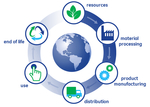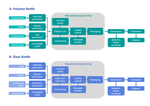Aims and objectives
This study compares environmental and operational impacts of two packaging options for contrast media: polymer bottle and traditional glass bottle.
The study includes all life cycle stages and evaluates a variety of end-of-life disposal scenarios,
with operational budget implications for health care facilities handling contrast media.
Life cycle assessment (LCA) is an internationally recognized methodology [1,2] that examines environmental impacts across the full life cycle of a product,
from raw material extraction and refining through manufacturing,
use,
and end-of-life disposal or recycling (Fig.
1).
By...
Methods and materials
The environmental impact assessment categories include greenhouse gas emissions,
cumulative energy demand,
human health,
ecosystems,
and resources.
Operational budget impact is modeled based on a comparison of medical waste disposal costs associated with contrast media packaging within a typical radiology department.
Environmental Life Cycle Assessment (LCA)
This study looks at the full life cycle of both polymer and glass bottles including supply chain,
product manufacturing,
distribution,
use,
and end-of-life.
The system boundaries for polymer and glass bottles are shown in Fig.
2.
Impact assessment methods...
Results
This study indicates that polymer bottles have considerably lower environmental impacts than glass across all categories.
Weight comparison of common bottle sizes indicated an average 78,7% reduction.
The specific medical waste disposal scenario for a typical US site shows that approximately 406 EUR can be saved annually assuming 11 700 units of contrast media consumed.
Environmental Life Cycle Assessment
The polymer bottle significantly outperforms the glass bottle for all environmental impact categories considered (Fig.
3).
Compared to glass,
the polymer bottle offers the following life...
Conclusion
The study results suggest that using polymer rather than glass can lower the environmental impact of contrast media packaging and reduce operational expenses related to disposal of contrast media packaging waste.
The lower environmental impacts of polymer bottles compared with glass bottles can be attributed to:
lower material and manufacturing impacts partly due to their lower mass
lower distribution impacts due to their lower mass
lower end-of-life disposal impacts due to lower mass and lower disposal impacts
The operational advantages of polymer bottles compared to...
Personal information
William P.
Flanagan,
PhD,
LCACP
Director – Ecoassessment Center of Excellence
General Electric Company
Niskayuna,
NY/US
[email protected]
Harnoor Dhaliwal
EarthShift LLC
Huntington,
VT/US
[email protected]
Martin Browne
Senior Scientist
GE Healthcare Life Sciences
Oslo/NO
[email protected]
References
ISO 14040:2006 - Environmental management - life cycle assessment - Principles and framework,
2006,
International Organisation for Standardization.
ISO 14044:2006 - Environmental management - life cycle assessment - Requirements and guidelines,
2006,
International Organisation for Standardization.
Goedkoop,
M.,
et al.,
“ReCiPe 2008: A life cycle impact assessment method which comprises harmonised category indicators at the midpoint and the endpoint level.” VROM–Ruimte en Milieu,
Ministerie van Volkshuisvesting,
Ruimtelijke Ordening en Milieubeheer,
2009.
Available from: http://www.lcia-recipe.net
Frischknecht R,
Jungbluth N,
Althaus H,
Doka G,
Dones R,
Heck...





